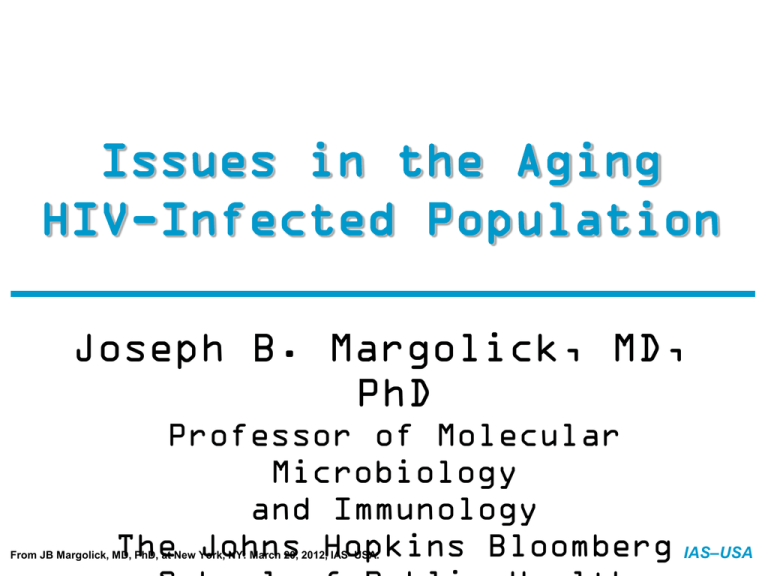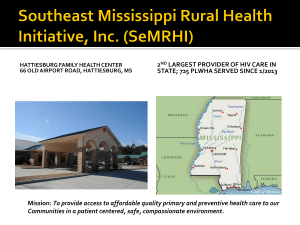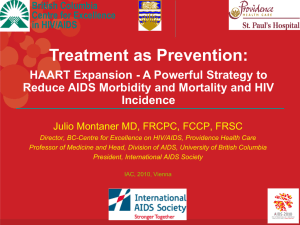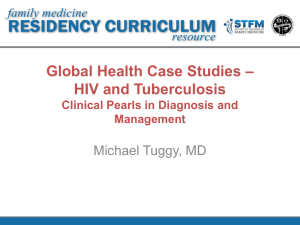
Issues in the Aging
HIV-Infected Population
Joseph B. Margolick, MD,
PhD
Professor of Molecular
Microbiology
and Immunology
The Johns Hopkins Bloomberg
From JB Margolick, MD, PhD, at New York, NY: March 20, 2012, IAS–USA.
IAS–USA
Slide #2
HIV and Aging
Proportion of HIV/AIDS population
that is >50
•
•
•
•
13.4% in 2001
15.2% in 2004
35% in 2011
50% in 2015
CDC, 2006, 2011
From JB Margolick, MD, PhD, at New York, NY: March 20, 2012, IAS–USA.
Slide #3
Similarities between HIV Infection and Aging
At the biological level
• T-lymphopenia, decreased cellular immunity
• Replicative senescence of T-lymphocytes
• pro-inflammatory markers (IL-6, TNF-α, IFN-γ)
At the clinical level
• Sarcopenia, weight loss, wasting
• Cognitive disorders, dementia
• Rheumatologic disorders, decrease in bone mineral
density
• Frailty-like clinical presentation, disability, and death
• (treated) Apparent earlier onset of chronic diseases
associated with aging
From JB Margolick, MD, PhD, at New York, NY: March 20, 2012, IAS–USA.
Age Issues in Effect of HIV/HAART
Slide #4
HIV as a “chronic disease”
• Age-related co-morbidities/toxicities (malignancies,
metabolic, cardiovascular, kidney, liver, neurologic)
• Interaction of HAART with age-related morbidities
HIV/HAART and age-related immunologic decline
•
•
•
•
•
Decreased T-cell replacement, esp. naive CD4
Decreased cellular response to HAART
Dysregulation leading to impaired responses
Residual immune activation on HAART
Frailty (may have immunologic component even in HIV-)
Methodologic issues
• Age as time axis for comparing by HIV serostatus
• Appropriate comparison group
‒ At-risk HIV-negatives, not general population
‒ Age-adjusted
From JB Margolick, MD, PhD, at New York, NY: March 20, 2012, IAS–USA.
Slide #5
The Aging Phenotype and the Genesis of Geriatric Syndromes
AGING
Aging
Phenotypes
Changes in
Body Comp
Discrepancy Energy
Production/Utilization
Disease Susceptibility
Reduced Functional Reserve
Reduced Healing Capacity
Unstable Health
Failure to Thrive
Homeostatic
Dysregulation
Neurodegeneration
FRAILTY
Cognitive
Impairment
Gait Disorders
Falls
Geriatric Syndromes
Delirium
Disability
Sarcopenia
From JB Margolick, MD, PhD, at New York, NY: March 20, 2012, IAS–USA.
Sleep Disorders
Urinary
Incontinence
Decubitus
Ulcers
Courtesy L Ferrucci - unpublished (do not cite)
Slide #6
Resting Energy Expenditure and
Covariates in HIV+ and HIV- Subjects
HIV-infected subjects, n = 259 Estimate (β) R2
P value
FFM (kg)
25.2079461
0.649 <.0001
Respiratory Quotient
(CO2 prod/O2 consumption)
−654.23617
0.665 .004
Dietary carbohydrate (g)
.43184009
0.674 .027
CT VAT (cm2)
.68024196
0.689 .004
Control subjects, n = 119
Estimate (β) R2
FFM (kg)
22.6017946
0.722 <.0001
CT VAT (cm2)
.99145624
0.806 <.0001
Total body fat (kg)
12.541516
0.812 .048
CT SAT (cm2)
−.6914458
0.818 .051
P value
BMR= 108± 1% Predicted
(p<.0001)
BMR= 98± 1% Predicted
Fitch et al, Metabolism: Clinical and Experimental 2009; 58:608-15
From JB Margolick, MD, PhD, at New York, NY: March 20, 2012, IAS–USA.
Slide #7
Changes in Immune Activation
Markers after HAART in the MACS
sCD27
sCD27
sCD30
sCD30
800
140
120
sCD27 U/mL
sCD30 U/mL
600
100
80
60
400
40
200
20
T1
T2
IL-6
T3
T4
HIV-
IL6
Plot 1
8
5
6
CRP ug/mL
IL6 pg/mL
4
3
CRP
C-Reactive Protein
4
2
2
1
0
0
From JB Margolick, MD, PhD, at New York, NY: March 20, 2012, IAS–USA.
Regidor D et al, AIDS. 2011;25:303-14.
Slide #8
Risk of Incident Diabetes Mellitus in the
Multicenter AIDS Cohort Study (1999-2003)
4 fold increased risk of DM in HAART-treated men
p= 0.001
* Adjusted for age and BMI at study entry
From JB Margolick, MD, PhD, at New York, NY: March 20, 2012, IAS–USA.
Brown et al, Arch Int Med, 2005
Slide courtesy of T. Brown
Slide #9
Homeostatic Systems Disrupted in
HIV Infection
System
Untreated
T-cell
X
Neurological X
Treated
X
X
Glucose
Hemoglobin
Fat
Muscle
X
minimal
X
X
X
X
X
X
“functional”
homeostasis
Even if a system looks normal, need to know:
how hard it is working to maintain that appearance!
if it can recover after a stress or injury
From JB Margolick, MD, PhD, at New York, NY: March 20, 2012, IAS–USA.
Frailty: A Brief Overview
Slide #10
Definition
“A central definition of frailty in geriatric medicine is that it is a clinical
state of vulnerability to stressors, […] resulting from aging-associated
declines in resiliency and physiologic reserves and a progressive
decline in the ability to maintain a stable homeostasis.” [1]
Frailty is a predictor of poor outcomes
- Falls
- Hospitalization
- Institutionalization
- Disability
- Mortality [2]
time
LP,MD,
et PhD,
al. 2005
Fried
LP et20,al,
2001
From[1]
JB Fried
Margolick,
at New [2]
York,
NY: March
2012,
IAS–USA.
Slide #11
Theorized and validated components of phenotype of
frailty with aging, related in an adverse feedforward cycle
Fried,
L.IAS–USA.
P. et al.
From JB Margolick, MD, PhD, at New York, NY: March
20, 2012,
J Gerontol A Biol Sci Med Sci 2009 64A:1049-1057
Slide #12
Theoretical Pathogenesis of Frailty [1]
Aging-associated energy dysregulation
syndrome
• Phenotype is a vicious cycle
• Triggered at multiple points in cycle
• Triggered by many diseases as a final
common pathway
‒ E.g., CHF, COPD, diabetes, cancers, renal
impairment, HIV, possibly others
• Greater number of abnormal physiologic
systems associated nonlinearly with increased
risk of frailty (emergent property)
[1] Fried LP et al, J Gerontol A Biol Sci Med Sci 2009 64A:1049-1057
From JB Margolick, MD, PhD, at New York, NY: March 20, 2012, IAS–USA.
Slide #13
Frailty: How Is It Recognized?
Definition of frailty phenotype: An individual is
“frail” if ≥ 3 components of these 5 are present [1]:
-
Physical shrinking (unintentional weight loss)
-
Weakness (grip strength)
-
Exhaustion (self-reported)
-
Slowness (time to walk 15 feet)
-
Low physical activity level (weighted score of kcal/week)
Validated phenotype and medical syndrome [2]
[1] Fried LP, et al. J. Gerontol. A Biol. Sci. Med. Sci. 2001; 56:M146-56.
[2] Bandeen-Roche K, et al, J. Gerontol. A Biol. Sci. Med. Sci. 2006; 61:262-66.
From JB Margolick, MD, PhD, at New York, NY: March 20, 2012, IAS–USA.
Slide #14
Frailty in HIV Infection: Why Is It Important?
Associated with adverse outcomes in nonHIV populations, and probably in HIV+
Associated with untreated HIV, but may
persist even after HAART and viral
suppression
• Treatment may contribute to frailty development
May be treatable or preventable
Better understanding of mechanisms would
inform treatment and studies of non-HIV
frailty
From JB Margolick, MD, PhD, at New York, NY: March 20, 2012, IAS–USA.
Slide #15
Multicenter AIDS Cohort Study (MACS)
Longitudinal study with semi-annual follow up
• Pittsburgh, Baltimore/DC, Chicago, Los Angeles
Enrolled 6972 men who have sex with men
• 4954 in 1984-5, 668 in 1987-90, 1350 in 2001-3
Behavior, neuropsychological, social, quality-of-life
measures
Medical history and physical examination
• Timed walking and hand-grip strength instituted in 2006
Laboratory tests and blood storage
• T-cells, HIV RNA, hepatitis serology, liver and kidney
function, lipid panel, urine protein/creatinine ratio
Clinical outcomes assessed continuously
• Confirmed by review of medical records
From JB Margolick, MD, PhD, at New York, NY: March 20, 2012, IAS–USA.
Slide #16
Frailty in the MACS (1994-2005)
Definition of a frailty-related phenotype (FRP)
▪ The FRP definition was based on the frailty phenotype of Fried et al.
▪ Components of the frailty phenotype:
▪ FRP in the MACS
- Physical shrinking (unintentional weight loss)
- available
- Weakness (grip strength)
- not available *
- Exhaustion (self-reported)
- available
- approximated (SF-36) *
- Slowness (time to walk 15 feet)
- Low physical activity level
(a weighted score of kilocalories/week)
- approximated (SF-36)
Exhaustion: During the past 4 weeks, as a result of your physical health, have you had
difficulty performing your work or other activities (for example, it took extra effort)?
Slowness: Does your health now limit you in walking several blocks?
Low physical activity: Does your health now limit you in vigorous activities, such as
running, lifting heavy objects, participating in strenuous sports?
* Grip strength and walking speed assessed directly in the MACS since 2006
Desquilbet
L et al,
From JB Margolick, MD, PhD, at New York, NY: March
20, 2012, IAS–USA.
J Gerontol A Biol Sci Med Sci 2007; 62:1279-86
Slide #17
Studies of a Frailty-Related Phenotype (FRP) in
the Multicenter AIDS Cohort Study (MACS)
4954 MSM (HIV- as well as HIV+) followed semiannually
since 1984
The FRP was present if ≥ 3 of the above 4 components were
answered “yes” (#1 and #2) or “yes, limited a lot” (#3 and #4)
Covariates: age, education, ethnicity, CD4 cell count, HIV
RNA
Study population
• MACS individuals enrolled before 1996
• Seroconverter and seroprevalent men
• ≥ 1 measurement of CD4 cell count between visit 21 and visit 41
Visits:
• All HIV+ visits between visit 21 and visit 41
Final study population: N = 1045 (N person-visits = 12,916)
• 98 men had no measurement of CD4 count
From JB Margolick, MD, PhD, at New York, NY: March 20, 2012, IAS–USA.
Slide #18
Frailty-Related Phenotype (FRP) and Duration
of HIV Infection (Pre-HAART Era)
Odds ratio [95% CI] to manifest the FRP*
13.0
[6.6-25.4]
30
14.7
[7.6-28.4]
25
Same FRP prevalence between a
20
15
10
5
55-year old man infected < 4 years
3.4
[1.2-9.1]
and a >65-year old uninfected man
Ref
0
0
0-4
4-8
8 - 12
Duration of HIV infection (years)
*Logistic regression models (GEE)
Desquilbet L, et al, J Gerontol A Biol Sci Med Sci 2007; 62:1279-86.
From JB Margolick, MD, PhD, at New York, NY: March 20, 2012, IAS–USA.
Slide #19
Relationship Between CD4 T-Cell Count and Prevalence of
Frailty-Related Phenotype (FRP), by Calendar Period
20
% FRP (95% CI)
15
------- 1994-1995
1996-1999
_____ 2000-2005
____
10
5
0
0
100
200
300
400
500
600
700
800
900 1000
CD4 T-cell count (cells/µl)
Desquilbet L et al, 2009; J. Acquir. Immune Def. Syndr. 50:299-306
From JB Margolick, MD, PhD, at New York, NY: March 20, 2012, IAS–USA.
Prognostic Effect of FRP on HAART Response
(AIDS-free at HAART Initiation)
Slide #20
% Alive without clinical AIDS
100
No FRP before HAART
80
Logrank p-value < 0.01
60
FRP before HAART
40
20
N
Events
Adjusted HR
No FRP before HAART
436
69
(16%)
1
FRP before HAART
36
13
(36%)
1.6 [0.9-3.1]
0
0
2
4
6
8
10
Time since HAART initiation (years)
Desquilbet
L et al,
From JB Margolick, MD, PhD, at New York, NY: March
20, 2012, IAS–USA.
J. Gerontol A Biol. Sci. Med. Sci., 66A:1030-1038, 2011.
Slide #21
Impact of FRP in the 3 years before HAART initiation
on subsequent clinical AIDS or death among 596 men
enrolled in the MACS, using multivariate Cox models
AIDS-free at HAART (N=472)
Exposures at HAART
initiation
AIDS at HAART (N=124)
aHR1 (95% CI)
P-value
aHR2 (95% CI)
P-value
Education ≥ college
1·01 (0·64 - 1·62)
0·96
0·87 (0·42 - 1·79)
0·70
Ethnicity = White non
Hispanic (vs others)
1·32 (0·65 - 2·68)
0·45
0·64 (0·24 - 1·71)
0·38
Age (per 10 years increase)
1·43 (1·03 - 1·99)
0·03
1·31 (0·77 - 2·22)
0·32
Nadir CD4+ T-cell count (per
100 cell/mm3 increase)3
0·85 (0·72 – 1·00)
0·05
0·94 (0·73 - 1·20)
0·61
Maximum plasma viral load
(per 1 log10 copies/ml
increase)3
2·08 (1·35 - 3·21)
< 0·01
1·31 (0·71 - 2·42)
0·38
Proportion of FRP visits
before HAART (for a 25%
increase)3
1·35 (1·01 - 1·80)
0·04
1·63 (1·25 - 2·13)
<0·01
FRP, frailty-related phenotype; aHR, hazard ratios adjusted for variables listed in the table; CI,
confidence interval; 1 adjusted hazard ratios for AIDS/death; 2 adjusted hazard ratios for death only;
3 within the 3 years before HAART
Desquilbet
L et
From JB Margolick, MD, PhD, at New York, NY: March 20,
2012, IAS–USA.
al, J. Gerontol A Biol. Sci. Med. Sci., 66A:1030-1038, 2011.
Slide #22
Frailty-Related Phenotype (FRP) in MACS
HIV-1 infection associated with >10-year earlier occurrence
of FRP [1]
Risk of FRP increased nonlinearly with decreasing CD4 cell
count, especially <~400/mm3 [2]
After adjusting for age and CD4 cell count, FRP prevalence
decreased after the introduction of HAART [2]
Older age, lower educational level, and clinical AIDS were
independently associated with FRP among HIV+ men [1]
Proportion and number of visits with FRP in 3 yrs before
starting HAART independently predicted risk of AIDS or
death after HAART, even in those with HIV suppression [3]
[1] Desquilbet L et al, J. Gerontol A Biol. Sci. Med. Sci. 62:1279-1286, 2007. [2] Desquilbet L et al, J.
Acquir. Immune Def. Syndr. 50:299-306, 2009. [3] Desquilbet L et al, J. Gerontol A Biol. Sci. Med. Sci.
66A:1030-1038, 2011.
From JB Margolick, MD, PhD, at New York, NY: March 20, 2012, IAS–USA.
Slide #23
Prevalence of Frailty Phenotype (%)
Prevalence of Frailty Phenotype by Age
and HIV Status (MACS, 2009-10)
80
60
40
33
20
19.9
14.8
0
-
Age (years)
<40
FP events
7
8.4
5.2
4.4
HIV
Total p-v
24
+
-
+
-
40-49
7
27
158 136
321
38
487
10
8.1
7.8
+
50-59
44
75
546 508
From JB Margolick, MD, PhD, at New York, NY: March 20, 2012, IAS–USA.
-
+
60-69
35
-
+
>70
32
18 5
351 161
75 15
Slide #24
Prevalence Ratio of Frailty Phenotype for HIV+
HAART vs. HIV- , by Age (MACS, 2009-10)
Prevalence Ratio of
Frailty Phenotype for HIV+ / HIV-
All HIV+ Person-Visits
4.0
HIV+ Person-Visits (VL < 50 c/mL)
4.0
p=0.01
3.5
p<0.01
3.0
3.0
p=0.03
2.5
2.5
2.0
1.2
2.0
2.0
1.8
1.5
1.0
p=0.03
3.5
1.4
0.5
0.5
0.0
0.0
<40
40-49
50-59
60-69
>70
Age (years)
From JB Margolick, MD, PhD, at New York, NY: March 20, 2012, IAS–USA.
1.6
1.5
1.0
0.92
1.9
1.2
0.9
<40
0.7
40-49
50-59
60-69
Age (years)
>70
Slide #25
150
100
0
50
Number of men
200
FP Occurrence in the MACS
(10/06-3/10)
1
2
3
4
5
6
7
Number of visits with FP
From JB Margolick, MD, PhD, at New York, NY: March 20, 2012, IAS–USA.
Age (years)
HIV status
HIVHIV+
Among HIV+
CD4+ count
(cells/ul)
HIV RNA
(log10 copies/ml)
Nadir CD4+ count
(cells/ul)
Peak HIV RNA
(log10 copies/ml)
History of AIDS, N
(%)
Currently on
HAART, N (%)
Ever FP
(n=410)
52 (46 - 59)
Never FP
(n=1661)
50 (43 - 56)
174 (42%)
236 (58%)
913 (55%)
748 (45%)
449
(284 – 623)
<1.7
(<1.7– 3.0)
240
(125 – 352)
5.1
(4.5 – 5.4)
56 (24)
549
(380 - 743)
<1.7
(<1.7 – 2.8)
286
(177 -390)
4.9
(4.4 – 5.2)
75 (10)
179 (76)
573 (77)
Multivariate Predictors of the Frailty
Phenotype (MACS)
Predictor
Age (years) (50-54)
<40
40-44
45-49
55-59
60-64
≥65
Race/ethnicity (black vs. non-hispanic white)
Education (≥ college degree vs. <)
Cigarette smoking (yes vs no)
Hepatitis C (yes vs no)
HIV status (HIV-)
HIV+, no history of AIDS
HIV+, history of AIDS
Comorbidities*
Depressive symptoms
History of diabetes
Kidney disease
From JB Margolick, MD, PhD, at*NS:
New York,
March
20, 2012, IAS–USA.
highNY:
blood
pressure,
liver disease,
cancer
aOR
95% CI
0.73
0.69
0.95
1.36
1.77
3.32
1.28
0.74
1.45
1.87
0.44, 1.23
0.43, 1.12
0.64, 1.4
0.93, 1.97
1.14, 2.74
2.06, 5.36
0.92,1.79
0.56, 0.99
1.10, 1.93
1.20, 2.90
1.24
2.27
0.92,1.67
1.45, 3.54
2.89
1.84
1.52
2.25, 3.71
1.29, 2.61
1.09, 2.13
Slide #26
Slide #27
Age distribution in the AIDS and general populations. Follow-up time at
risk for cancer in both the AIDS and general populations, by age, for
regions covered by the HIV/AIDS Cancer Match Study (1996 to 2007).
Shiels M S et al. Ann Intern Med 2010;153:452-460
©2010
American
College
Physicians
From
JBby
Margolick,
MD,
PhD, at of
New
York, NY: March 20, 2012, IAS–USA.
Slide #28
Age at cancer diagnosis among persons with AIDS and the general
population in the United States, 1996–2007. Points represent cases of
cancer observed among persons with AIDS.
Shiels M S et al. Ann Intern Med 2010;153:452-460
©2010
American
College
Physicians
From
JBby
Margolick,
MD,
PhD, at of
New
York, NY: March 20, 2012, IAS–USA.
Slide #29
Directly Measured* Glomerular
Filtration Rate by Age and HIV Status
*By iohexol clearance, Multicenter AIDS Cohort Study; Margolick J et al, CROI 2012
From JB Margolick, MD, PhD, at New York, NY: March 20, 2012, IAS–USA.
Conclusions
Slide #30
Frailty phenotype (FP) is measurable in HIV+ men
• Clinical impact of FP in HIV+ unknown, but FRP data suggest
may be adverse (as in HIV- elderly)
Longitudinal studies are needed to evaluate
phenotypes, mechanisms, prognostic impact,
treatment, and prevention of frailty, and the role of
ART and HIV-associated comorbidities in HIV+
• Residual immune activation, chronic infections, aging itself
• Perturbation of normal homeostatic mechanisms by HIV/ART
• Interaction of HIV and aging may occur at intermediate ages
• Organ-, cellular- and biochemical-level mechanisms of aging
‒ FP is only a phenotype, not a true definition of frailty
Proper comparison groups critical for studies
• Be wary of comparison to general population
From JB Margolick, MD, PhD, at New York, NY: March 20, 2012, IAS–USA.
Slide #31
Clinical Implications of Studies of
Aging and Frailty in HIV Infection
Frailty (phenotype) may be more reversible in
HIV+ than in elderly HIVAttention to treatable or preventable
coinfections and comorbidities
• Hx of AIDS
Intervention studies and longitudinal studies
are still to be done in HIV+
• Reduction of HIV reservoirs
• Anti-inflammatory Rx
• Exercise, diet, quit smoking, mental health
Restrain presumptions about “premature” or
“accelerated” aging
From JB Margolick, MD, PhD, at New York, NY: March 20, 2012, IAS–USA.
Slide #32
“HIV and Premature Aging: A Field
Still in Its Infancy”
Although the hypothesis of premature aging in HIV
infection is intriguing, we suggest that it remain a
hypothesis—for now—and not become ingrained as a
complication of HIV infection before its time. To mature
this concept from hypothesis to fact will require
considerably more research to develop consensus in
definitions, valid epidemiologic studies to demonstrate
potential examples of premature aging, and a much
better understanding of the normal biological
process of aging. The latter requirement is probably
the hardest to achieve, but it is essential if we are to
confirm or refute that HIV truly accelerates
aging.[emphases added]
-J Martin and P Volberding, Ann. Intern. Med. 2010; 153: 477-479
From JB Margolick, MD, PhD, at New York, NY: March 20, 2012, IAS–USA.
Slide #33
Acknowledgements
Multicenter AIDS
Cohort Study (MACS)
• J. Phair (Chicago)
• R. Detels, B. Jamieson,
O. Martinez, D. Regidor
(Los Angeles)
• L. Jacobson, X. Li, K.
Althoff, T. Brown
(Baltimore)
• C. Rinaldo, M. Holloway
(Pittsburgh)
Columbia Mailman
School of Public
Health
• L. Fried
Ecole Nationale
Veterinaire d’Alfort
• L. Desquilbet
NIA
• L. Ferrucci
From JB Margolick, MD, PhD, at New York, NY: March 20, 2012, IAS–USA.







